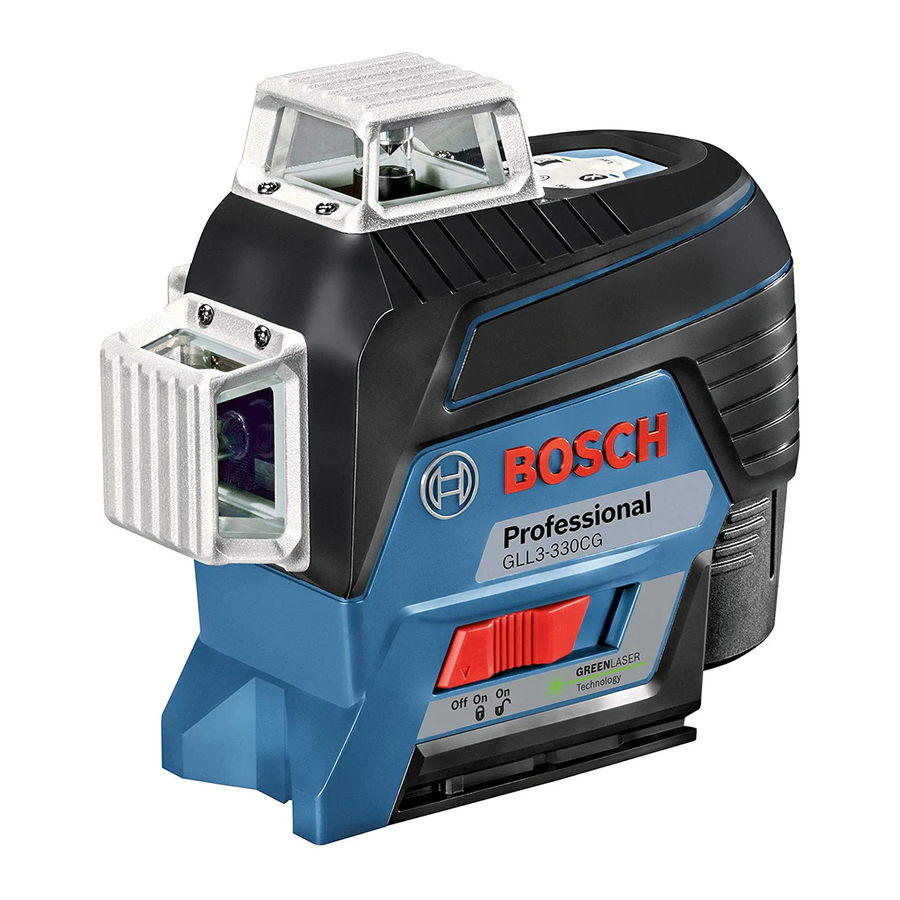
Bosch GLL3-330C, GLL3-330CG, GLL330-80CGN Manual
- Operating/safety instructions manual (19 pages) ,
- Operating/safety instructions manual (49 pages)
Advertisement
- 1 Safety Symbols
- 2 General Safety Rules
- 3 Bluetooth
- 4 Intended Use
- 5 Features
- 6 Technical Data
- 7 Preparation
- 8 Operation
- 9 Leveling Accuracy
- 10 Use with Attachments
- 11 Maintenance and Service
- 12 LIMITED WARRANTY
- 13 Documents / Resources

Safety Symbols
The definitions below describe the level of severity for each signal word. Please read the manual and pay attention to these symbols.
 | This is the safety alert symbol. It is used to alert you to potential personal injury hazards. Obey all safety messages that follow this symbol to avoid possible injury or death. |
 | WARNING indicates a hazardous situation which, if not avoided, could result in death or serious injury. |
General Safety Rules
Read all instructions. Failure to follow all instructions listed below may result in hazardous radiation exposure, electric shock, fire and/or serious injury. The term "tool" in all of the warnings listed below refers to your mains-operated (corded) tool or battery-operated (cordless) tool.

The following labels are on your laser tool for your convenience and safety. They indicate where the laser light is emitted by the tool. ALWAYS BE AWARE of their location when using the tool.
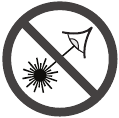
Do not direct the laser beam at persons or animals and do not stare into the laser beam yourself. This tool produces laser class 2 laser radiation and complies with 21 CFR 1040.10 and 1040.11 except for deviations pursuant to Laser Notice No. 50, dated June 24, 2007. This can lead to persons being blinded.
DO NOT remove or deface any warning or caution labels. Removing labels increases the risk of exposure to laser radiation.
Use of controls or adjustments or performance of procedures other than those specified in this manual, may result in hazardous radiation exposure.
ALWAYS make sure that any bystanders in the vicinity of use are made aware of the dangers of looking directly into the laser tool.
DO NOT place the laser tool in a position that may cause anyone to stare into the laser beam intentionally or unintentionally. Serious eye injury could result.
ALWAYS position the laser tool securely. Damage to the laser tool and/or serious injury to the user could result if the laser tool fails.
ALWAYS use only the accessories that are recommended by the manufacturer of your laser tool. Use of accessories that have been designed for use with other laser tools could result in serious injury.
DO NOT use this laser tool for any purpose other than those outlined in this manual.
This could result in serious injury.
DO NOT leave the laser tool "ON" unattended in any operating mode.
DO NOT disassemble the laser tool. There are no user serviceable parts inside. Do not modify the product in any way. Modifying the laser tool may result in hazardous laser radiation exposure.
DO NOT use the laser viewing glasses as safety goggles. The laser viewing glasses are used for improved visualization of the laser beam, but they do not protect against laser radiation.
DO NOT use the laser viewing glasses as sun glasses or in traffic. The laser viewing glasses do not afford complete UV protection and reduce color perception.
DO NOT use any optical tools such as, but not limited to, telescopes or transits to view the laser beam. Serious eye injury could result.
DO NOT stare directly at the laser beam or project the laser beam directly into the eyes of others. Serious eye injury could result.
Work area safety
Keep work area clean and well lit. Cluttered or dark areas invite accidents.
DO NOT operate the laser tool around children or allow children to operate the laser tool. Serious eye injury could result.
DO NOT use laser tools, attachments and accessories outdoors when lightning conditions are present.
Do not operate the laser tool in explosive environments, such as in the presence of flammable liquids, gases or dusts. Sparks can be created in the laser tool which may ignite the dust or fumes.
Electrical safety
Batteries can explode or leak, cause injury or fire. To reduce this risk, always follow all instructions and warnings on the battery label and package.
DO NOT expose the laser tool and battery to rain or wet conditions. Water entering laser tool will increase the risk of fire and personal injury.
DO NOT short any battery terminals.
DO NOT charge alkaline batteries. DO NOT mix old and new alkaline batteries. Replace all of them at the same time with new batteries of the same brand and type.
DO NOT mix battery chemistries.
Dispose of or recycle batteries per local code.
DO NOT dispose of batteries in fire.
Keep batteries out of reach of children.
Remove batteries if the device will not be used for several months.
Personal safety
If laser radiation strikes your eye, you must deliberately close your eyes and immediately turn your head away from the beam.
Do not make any modifications to the laser equipment.
Stay alert, watch what you are doing and use common sense when operating a tool. Do not use a tool while you are tired or under the influence of drugs, alcohol or medication. A moment of inattention while operating a tool may result in serious personal injury or incorrect measurement results.
Use safety equipment. Always wear eye protection. Safety equipment such as dust mask, non-skid safety shoes, hard hat, or hearing protection used for appropriate conditions will reduce personal injuries.
Use caution when using laser tools in the vicinity of electrical hazards.
Prevent unintentional starting. Ensure the switch is in the off-position before inserting batteries. Accidental energizing laser tool that have the switch on invites accidents.
Chemical Burn Hazard.
Keep lithium button/coin batteries away from children. This product contains a lithium button/coin cell battery. If a new or used lithium button/coin cell battery is swallowed or enters the body, it can cause severe internal burns and can lead to death in as little as 2 hours. Always completely secure the battery compartment. If the battery compartment does not close securely, stop using the product, remove the batteries, and keep it away from children. If you think batteries might have been swallowed or placed inside any part of the body, seek immediate medical attention.
Magnets

Keep the tool, positioning device BM 1 24, laser receiver LR 6/LR8 25, and laser target plate 26 away from implants or other medical devices such as pacemaker or insulin pumps. The magnets generate a field that can impair the function of implants or medical devices, which may lead to serious personal injury.
Keep the tool, positioning device BM 1 24, laser receiver LR 6/LR8 25, and laser target plate 26 away from magnetic data storage medium and magnetically sensitive equipment. The effect of the magnets can lead to irreversible data loss.
Noise Information
The A-weighted sound pressure level of the audio signal at one meter distance is 80dB(A). Do not hold the laser tool close to your ear!
Use and care
Use the correct tool for your application. The correct tool will do the job better and safer.
Do not use the tool if the switch does not turn it on and off. Any tool that cannot be controlled with the switch is dangerous and must be repaired.
Store idle tool out of the reach of children and do not allow persons unfamiliar with the tool or these instructions to operate the tool. Tools are dangerous in the hands of untrained users.
Maintain tools. Check for misalignment or binding of moving parts, breakage of parts and any other condition that may affect the operation. If damaged, tool repaired before use. Many accidents are caused by poorly maintained tools.
Use the tool, accessories, etc., in accordance with these instructions and in the manner intended for the particular type of tool, taking into account the working conditions and the work to be performed. Use of the tool for operations different from those intended could result in a hazardous situation.
Battery tool use and care
Recharge only with the charger specified by the manufacturer. A charger that is suitable for one type of battery pack may create a risk of fire when used with another battery pack.
Use laser tools only with specifically designated battery packs. Use of any other battery packs may create a risk of injury and fire.
When battery pack is not in use, keep it away from other metal objects like paper clips, coins, keys, nails, screws, or other small metal objects that can make a connection from one terminal to another. Shorting the battery terminals together may cause burns or a fire.
Under abusive conditions, liquid may be ejected from the battery; avoid contact. If contact accidentally occurs, flush with water. If liquid contacts eyes, additionally seek medical help. Liquid ejected from the battery may cause irritation or burns.
Do not use a battery pack or tool that is damaged or modified. Damaged or modified batteries may exhibit unpredictable behaviour resulting in fire, EXPLOSION or risk of injury.
Do not expose a battery pack or tool to fire or excessive temperature. Exposure to fire or temperature above 265°F (130°C) may cause explosion.
Follow all charging instructions and do not charge the battery pack or tool outside the temperature range specified in the instructions. Charging improperly or at temperatures outside the specified range may damage the battery and increase the risk of fire.
Disconnect the battery pack from the tool before making any adjustments, changing accessories, or storing the tool. Such preventive safety measures reduce the risk of starting the tool accidentally.
Do not modify or attempt to repair the tool or the battery pack except as indicated in the instructions for use and care.
Service
Have your tool serviced by a qualified repair person using only identical replacement parts. This will ensure that the safety of the tool is maintained.
Develop a periodic maintenance schedule for tool. When cleaning a tool be careful not to disassemble any portion of the tool since internal wires may be misplaced or pinched or may be improperly mounted. Certain cleaning agents such as gasoline, carbon tetrachloride, ammonia, etc. may damage plastic parts.
SAVE THESE INSTRUCTIONS.
Bluetooth
Do not use the laser tool with Bluetooth in the vicinity of gas stations, chemical plants, areas where there is danger of explosion and areas subject to blasting. Do not use the laser measure with Bluetooth in airplanes. Do not use the laser measure with Bluetooth in the vicinity of medical devices. Avoid operation in the direct vicinity of the human body over longer periods of time. When using the laser measure with Bluetooth, interference with other devices and systems, airplanes and medical devices (e.g., cardiac pacemakers, hearing aids) may occur.
Intended Use
The tool is intended for determining and checking horizontal and vertical lines. The measuring tool is suitable for indoor and outdoor use.
Features
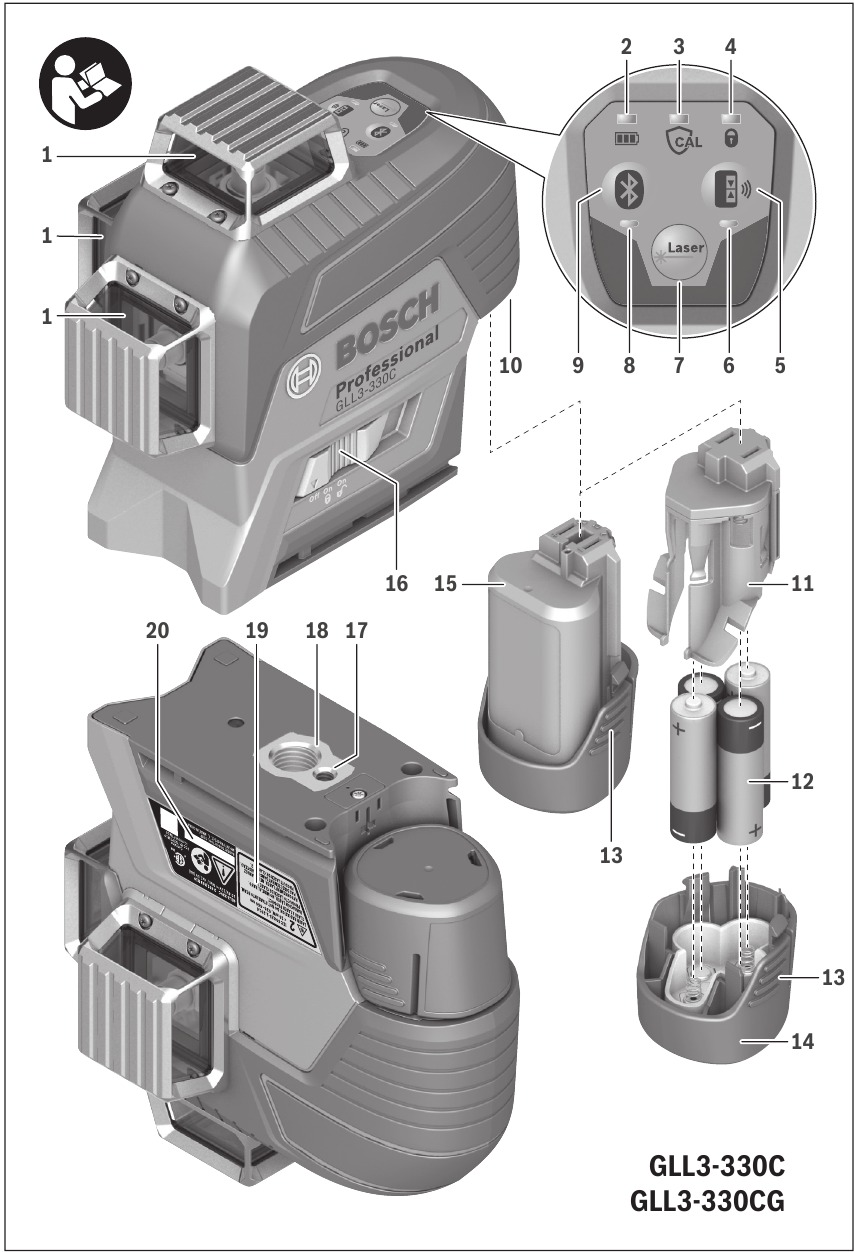
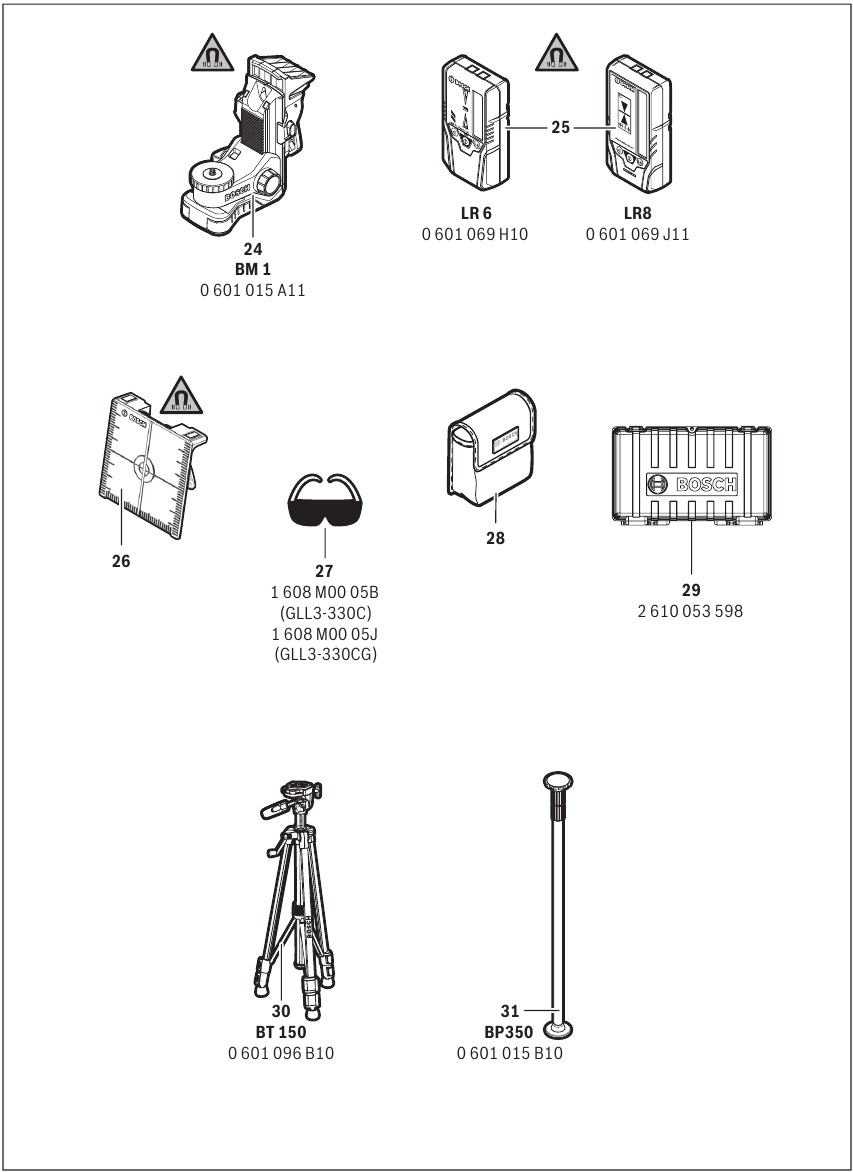
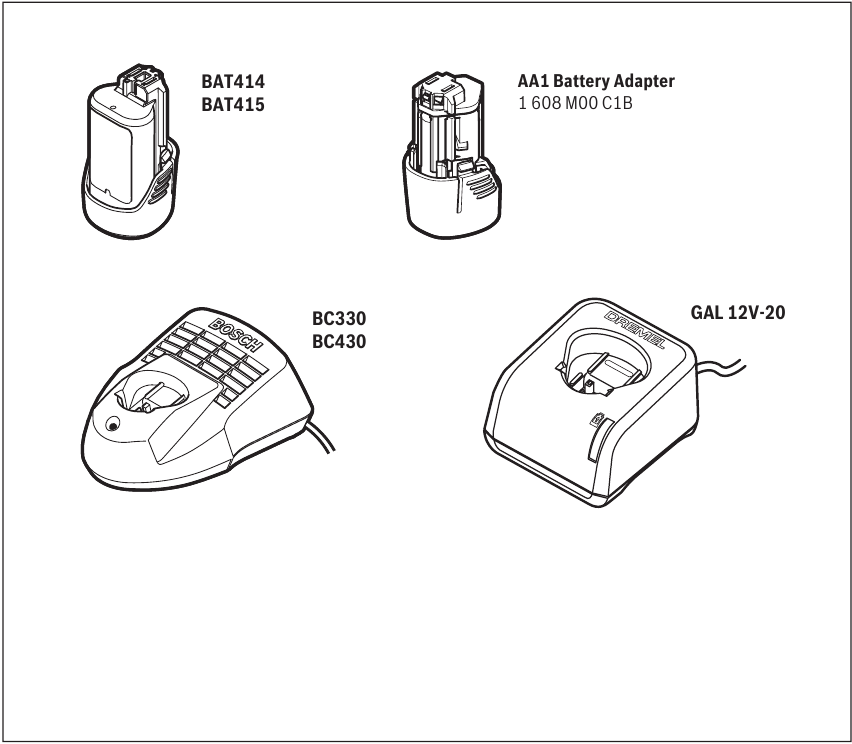
- Exit opening for laser beam
- Charging condition of battery pack/batteries
- CAL guard indicator
- Working without automatic leveling indicator
- Receiver mode button
- Receiver mode indicator
- Button for laser operating mode
- Indicator for Bluetooth connection
- Bluetooth button
- Battery port
- Battery adapter cover
- Batteries*
- Battery release tab for battery pack/battery adapter
- Battery adapter sealing cap
- Battery pack
- On/Off switch
- Tripod mount 1/4"
- Tripod mount 5/8"
- Laser warning label
- Serial number
- Button cell
- Button cell holder
- Button cell port
- Positioning device BM 1
- Laser receiver*
- Laser target plate
- Laser viewing glasses*
- Protective pouch
- Hard Carrying Case
- Tripod BT 150*
- Telescopic rod BP350*
*The accessories illustrated or described are not included as standard delivery.
Technical Data
| Laser Line | GLL3-330C | GLL3-330CG | |
| Article number | 3 601 K63 R10 | 3 601 K63 T10 | |
| Working range 1) | without laser receiver (diameter) | 200 ft (60m) | 200 ft (60m) |
| with laser receiver (diameter) | 30-330 ft (10-100m) | 30-330 ft (10-100m) | |
| Leveling Accuracy 2) 3) 4) | ±3/32 in. at 30 ft (±2.5 mm at 10 m) | ±3/32 in. at 30 ft (±2.5 mm at 10 m) | |
| Self-leveling range (typical) | ±4° | ±4° | |
| Leveling duration (typical) | <4s | <4s | |
| Operating temperature | 14°F ~104°F (–10°C ~ +40°C) | 14°F ~104°F (–10°C ~ +40°C) | |
| Storage temperature | Laser Level | -4°F ~ 158°F (–20°C ~ +70°C) | -4°F ~ 158°F (–20°C ~ +70°C) |
| Battery | 32°F ~122°F (0°C ~ +50°C) | 32°F ~122°F (0°C ~ +50°C) | |
| Charging temperature | 32°F ~ 113°F (0°C ~ +45°C) | 32°F ~ 113°F (0°C ~ +45°C) | |
| Max. altitude | 6560 ft (2000 m) | 6560 ft (2000 m) | |
| Relative air humidity, max. | 90% | 90% | |
| Pollution degree according IEC 61010 5) | 2 | 2 | |
| Laser class | 2 | 2 | |
| Laser type | 630-650 nm, <10 mW | 500-540 nm, <10 mW | |
| Tripod mount | 1/4"-20, 5/8"-11 | 1/4"-20, 5/8"-11 | |
| Laser tool power supply | Battery pack (lithium-ion) | 10.8 V/12 V | 10.8 V/12 V |
| Batteries (alkali-manganese) | 4 x 1.5 V LR6 (AA) (with battery adapter) | 4 x 1.5 V LR6 (AA) (with battery adapter) | |
| Operating time with 3 laser levels 6) | with battery pack (BAT414) | 8 h | 6 h |
| with batteries | 6 h | 4 h | |
| Battery Charger List | Rechargeable Batteries | BAT414, BAT415 | BAT414, BAT415 |
| Chargers | BC330, BC430 GAX1218V-30, GAL 12V-20 | BC330, BC430 GAX1218V-30, GAL 12V-20 | |
| Button cell | CR2032 (3 V lithium battery) | CR2032 (3 V lithium battery) | |
| Bluetooth laser tool Compatibility 7) | Bluetooth (Low Energy) | Bluetooth (Low Energy) | |
| Bluetooth smartphone 7) | Compatibility | Bluetooth (Low Energy) | Bluetooth (Low Energy) |
| Operating system | Android 6 (and above) iOS 11 (and above) | Android 6 (and above) iOS 11 (and above) | |
| Weight | 2lb (0.9 kg) | 2lb (0.9 kg) | |
| Dimensions | 6.4" x 3.3" x 5.8" (162 x 84 x 148 mm) | 6.4" x 3.3" x 5.8" (162 x 84 x 148 mm) | |
| Degree of protection 8) | IP 54 (dust and splash water protected) | IP 54 (dust and splash water protected) | |
1) The working range can be decreased by unfavorable environmental conditions (e.g. direct sun irradiation).
2) At 68 - 77 ºF (20 - 25 ºC).
3) Applies to the 4 horizontal intersection points.
4) The values stated presuppose normal to favorable environmental conditions (e.g. no vibration, no fog, no smoke, no direct sunlight). Extreme fluctuations in temperature can cause deviations in accuracy.
5) Conductive pollution occurs, or dry, non-conductive pollution occurs which becomes conductive due to condensation, which is expected. In such conditions, equipment is normally protected against exposure to direct sunlight, precipitation, and full wind pressure, but neither temperature nor humidity is controlled.
6) Shorter operating times in Bluetooth operation.
7) For Bluetooth low energy devices, establishing a connection may not be possible, depending on model and operating system. Bluetooth devices must support the SPP profile.
8) Battery port, battery packs, and AA1 battery adapter not included.
Technical data determined with battery from delivery scope.
The laser tool can be clearly identified with the serial number 20 on the type plate.
Preparation
Unit Power Supply
The laser tool can either be operated with commercially available LR6 (AA) batteries or with a Bosch rechargeable lithium-ion battery pack.
Operation with Bosch Rechargeable Lithium-ion Battery Pack
Use only Bosch rechargeable lithium-ion battery packs listed in the technical data section of this manual. Use of other battery packs may increase the risk of fire, personal injury and property damage.
Note: The battery pack is supplied partially charged. To ensure full capacity of the battery pack, completely charge the battery pack in the battery charger before using for the first time.
Use only Bosch chargers listed in the technical data section of this manual. Use of other chargers may increase the risk of fire, personal injury and property damage.
The lithium-ion battery pack can be charged at any time without reducing its service life. Interrupting the charging procedure does not damage the battery pack.
The "Electronic Cell Protection (ECP)" protects the lithium-ion battery pack against deep discharging. When the battery pack is discharged, the laser tool is switched off by a protective circuit.
- Do not switch the laser tool back on after it has been switched off by the protective circuit. The battery pack can be damaged.
To insert the charged battery pack 15, align battery pack and slide it into the battery port until it locks into position. Don't force.
To remove the battery pack 15, press the battery release tab 13 and pull the battery pack out of the battery port 10. Do not use force to do this.
Operation with LR6 AA Batteries
Alkali-manganese batteries are recommended for the laser tool. The batteries are inserted into the battery adapter.
- The non-rechargeable battery adapter is intended only for use in designated Bosch laser tools and must not be used with power tools.
To insert the batteries, slide the cover 11 of the battery adapter into the battery port 10. Place the batteries in the cover as shown in the illustration on the sealing cap 14. Slide the sealing cap over the cover until you feel it click into place.
To remove the batteries 12 press the battery release tab 13 of the sealing cap 14 and pull off the sealing cap. Make sure that the batteries do not fall out. To do so, hold the laser tool with the battery port 10 facing upward. Remove the batteries.
To remove the inside cover 11 from the battery port 10, reach into the cover and pull it out of the laser tool by applying light pressure to the side wall.
Always replace all batteries at the same time. Only use batteries from one brand and with the identical capacity.
- Remove the batteries from the laser tool when not using it for extended periods. When storing for extended periods, the batteries can corrode and self-discharge.
Battery Status Indicator
The battery status indicator 2 shows the charge condition of the battery pack or batteries:
| LED | Charge Condition |
| Continuous lighting, green | 100–75% |
| Continuous lighting, yellow | 75–35% |
| Continuous lighting, red | 35–10% |
| No light |
|
If the battery pack or the batteries are running low, the laser lines will gradually become dimmer.
Immediately replace a fault battery pack or empty batteries.
Button Cell Activation/Replacement
To enable the communication of this laser leveling tool in the off state to a mobile terminal/device, the laser leveling tool is equipped with a button cell.
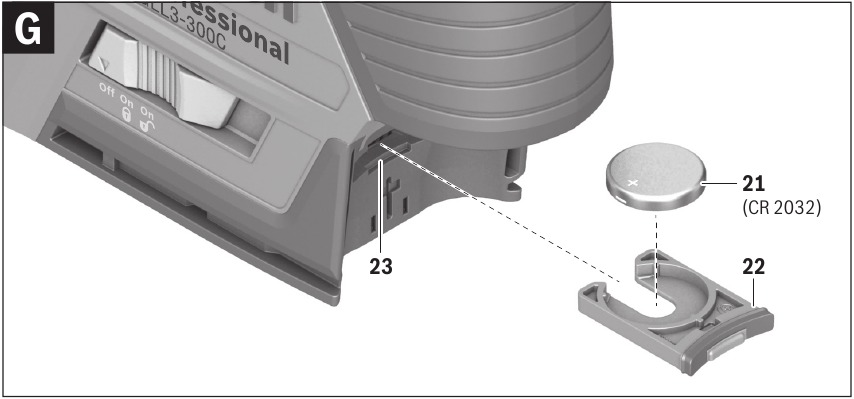
(see Fig. G)
To activate the included button cell:
- Remove the button cell holder 22 from the button cell port 23.
- Remove the protective film from the button cell 21.
- Insert the button cell 21 (CR2032) into the button cell holder 22. Make sure that the positive pole is pointing upwards.
- Insert the button cell holder 22 into the button cell port 23.
- Ensure button cell holder 22 is secured into button cell port 23.
When replacing a button cell, follow step 1 and steps 3-5.
When the button cell runs out of energy, the app displays a warning.
Chemical Burn Hazard.
Keep lithium button/coin batteries away from children. This product contains a lithium button/coin cell battery. If a new or used lithium button/coin cell battery is swallowed or enters the body, it can cause severe internal burns and can lead to death in as little as 2 hours. Always completely secure the battery compartment. If the battery compartment does not close securely, stop using the product, remove the batteries, and keep it away from children. If you think batteries might have been swallowed or placed inside any part of the body, seek immediate medical attention.
Operation
Initial Operation
- Loud audio signals will sound under certain conditions while operating the tool. Therefore, keep the tool away from your ear or other persons. The loud audio signal can cause hearing damage.
- Protect the tool against moisture and direct sun light.
- Do not subject the tool to extreme temperatures or variations in temperature. As an example, do not leave it in vehicles for extended periods of time. In case of large fluctuations in temperate, allow the tool to adjust to the ambient temperate and then perform an accuracy check before continuing work (see "Leveling Accuracy" section). In case of extreme temperatures or variations in temperature, the accuracy of the tool can be impaired.
- Avoid heavy impact or dropping of the tool. After heavy exterior impact on the tool, an accuracy check should always be carried out before continuing to work (see "Leveling Accuracy").
- Switch the tool off during transport. When switching off, the leveling unit, which can be damaged in case of intense movement, is locked.
Switching On and Off
Do not point the laser beam at persons or animals and do not look into the laser beam yourself, not even from a large distance.
Do not leave the switched on tool unattended and switch the tool off after use.
To switch on the tool, slide the On/Off switch 16 to the " ![]() on". position (when working without automatic leveling) or to the "on" position (when working with automatic leveling). Immediately after switching on, the tool sends laser beams out of the exit openings 1.
on". position (when working without automatic leveling) or to the "on" position (when working with automatic leveling). Immediately after switching on, the tool sends laser beams out of the exit openings 1.
To switch off the tool, slide the On/Off switch 16 to the " ![]() off " position. When switching off, the leveling unit is locked.
off " position. When switching off, the leveling unit is locked.
When exceeding the maximum permitted operating temperature of 104°F, the tool switches off to protect the laser diode. After cooling down, the tool is ready for operation and can be switched on again.
Automatic Shut-off
When no button on the tool is pressed for approx. 120 minutes, the tool automatically switches off to save the batteries.
To switch on the tool after automatic shut-off, either slide the On/Off switch 16 to the "off" position and then switch the tool on again or press the operating mode button 7 once or press the receiver mode button 5 once.
Deactivating the Automatic Shut-off
To deactivate the automatic shut-off, keep the operating mode button 7 pressed for at least 3 s (while the tool is switched on). Deactivation of the automatic shut-off is confirmed by brief flashing of the laser beams.
Activating the Automatic Shut-off
To activate the automatic shut-off, switch the tool off and then on again.
Deactivating the Signal Tone
After the tool has been switched on, the audio signal is always activated.
To deactivate/activate the audio signal, press and hold the operating mode button 7 and the receiver mode button 5 at the same time for at least 3 s.
The audio signal activation and deactivation are both confirmed by three short beeps.
Operating Modes
The tool has several operating modes between which you can switch at any time:
- Generating a horizontal laser plane,
- Generating a vertical laser plane,
- Generating two vertical laser planes,
- Generating a horizontal laser plane as well as two vertical laser planes.
After switching on, the tool generates a horizontal laser plane. To change the operating mode, press the operating mode button 7.
All operating modes can be selected with or without automatic leveling.
Receiver Mode
When working with the laser receiver 25, the receiver mode must be activated, – independent of the selected operating mode.
In receiver mode, the laser lines flash at very high frequency and thus become detectable by the laser receiver 25.
To switch on receiver mode, press button 5. When receiver mode is switched on, the receiver mode indicator 6 lights up green.
When receiver mode is switched on, the visibility of the laser lines is reduced for the human eye. Therefore, shut off receiver mode by pushing button 5 again when working without laser receiver. When receiver mode is switched off, the receiver mode indicator 6 is deactivated.
Automatic Leveling
Working with Automatic Leveling
Position the tool on a level and firm support, attach it to the BM 1 positioning device 24 or to the tripod 30.
When working with automatic leveling, push the On/Off switch 16 to the " ![]() on" position.
on" position.
After switching on, the leveling function automatically compensates irregularities within the self-leveling range of ±4°. The leveling is finished as soon as the laser beams do not move any more.
If automatic leveling is not possible, e.g. because the surface on which the tool stands deviates by more than 4° from the horizontal plane, the laser lines begin to flash rapidly.
When the audio signal is activated, a fast-beat signal sounds for 30 s (maximum). This alarm is deactivated within 10 s after switching on, in order to allow adjustment of the tool.
Set up the tool in level position and wait for the self-leveling to take place. As soon as the tool is within the self-leveling range of ±4°, all laser beams light up continuously and the audio signal is switched off.
In case of ground vibrations or position changes during operation, the tool is automatically leveled in again. To avoid errors, check the position of the horizontal and vertical laser line with regard to the reference points upon releveling.
Working without Automatic Leveling
For working without automatic leveling, slide the On/Off switch 16 to the " ![]() on" position.
on" position.
When automatic leveling is switched off, indicator 4 lights up red and for the first 30 s laser beams flash slowly.
When the automatic leveling is switched off, the tool can be held by hand or placed on an inclined surface. In cross-line operation, the two laser lines do not necessarily run at a right angle to each other.
Remote control via the Leveling Remote App
The laser tool is equipped with a Bluetooth module which uses radio technology to enable remote control via a smartphone with a Bluetooth interface.
The "Leveling Remote App" application (app) is needed to use this function. You can download this in the app store for your terminal device (Apple App Store, Google Play Store).
For information on the necessary system requirements for a Bluetooth connection, please refer to the Bosch website at www.bosch-pt.com
When remote controlling by means of Bluetooth, time lags may occur between mobile terminal/device and laser tool as a result of poor reception conditions.
Switching On Bluetooth
Do not turn on laser remotely using the Bosch app without line of sight to the laser tool. The sudden bright laser beam may increase the risk of personal injury or property damage.
Ensure there are no bystanders in the direct path of the laser beam before turning on the laser remotely.
To switch on Bluetooth for the remote control, press the Bluetooth-button 9. Ensure that the Bluetooth interface is activated on your mobile terminal/device.
After starting the Bosch application, the connection between the mobile terminal/ device and the laser tool is established. When several active laser tools are found, select the appropriate laser tool. When only one active laser tool is found, the connection is automatically established.
The connection is established as soon as the Bluetooth indicator 8 lights up.
The Bluetooth connection may be interrupted if there is too much distance or there are obstacles between laser tool and mobile terminal/device and if there are any electromagnetic interference sources. In this case, the Bluetooth indicator flashes.
Switching Off Bluetooth
To switch off Bluetooth for the remote control, press the Bluetooth-button 9 or switch off the laser tool.
CAL Guard Calibration Warning
The CAL guard calibration warning sensors monitor the status of the laser tool, even when it is switched off. If the laser tool is not being supplied with power by a battery pack or batteries, an internal energy storage battery provides continuous monitoring by the sensors for 72 hours.
The sensors are activated when the laser tool is started up for the first time.
Calibration warning triggers
If one of the following events occurs, the CAL guard calibration warning is triggered and the indicator 3 lights up red:
- The calibration interval (every 12 months) has expired.
- The laser tool was stored outside of the storage temperature range.
- The laser tool suffered a severe shock (e.g. impact on the floor after a fall).
You can refer to the "Leveling Remote App" to see which of the three events triggered the calibration warning. Without the app, the cause cannot be identified as the CAL guard indicator, the CAL guard indicator 3 lighting up indicates merely that the leveling accuracy needs to be checked.
Once the warning has been triggered, the CAL guard indicator 3 lights up until the leveling accuracy has been checked and the indicator switched off.
Procedure in the event of a calibration warning being triggered
Check the leveling accuracy of the laser tool (see "Accuracy Check of the Laser Tool").
If the maximum deviation has not been exceeded in any of the tests, switch the CAL guard indicator 3 off. To do so, press and hold the receiver mode button 5 and the Bluetooth button 9 at the same time for at least 3 s. The CAL guard indicator 3 goes out.
Should the laser tool exceed the maximum deviation during one of the tests, please have it repaired by a Bosch after-sales service.
Working Advice
- Always use the center of the laser line for marking. The width of the laser line changes with the distance.
Leveling Accuracy
Influences on Accuracy
The ambient temperature has the greatest influence. Especially temperature differences occurring from the ground upward can refract the laser beam.
Because the largest difference in temperature layers is close to the ground, the tool should always be mounted on a tripod when distances exceeding 65 ft. If possible, also set up the tool in the center of the work area.
Apart from exterior influences, device-specific influences (such as heavy impact or falling down) can lead to deviations. Therefore, check the accuracy of the tool each time before starting your work.
Firstly, check the leveling accuracy of the horizontal laser line and then the leveling accuracy of the vertical laser line.
Should the tool exceed the maximum deviation during one of the tests, please have it repaired by a Bosch after-sales service.
Checking the Horizontal Leveling Accuracy
A free measuring distance of 16 ft (5 m) on a firm surface in front of two walls A and B is required for the check.
- Mount the tool onto a tripod, or place it on a firm and level surface close to the wall A. Switch the tool on. Select cross-line operation with automatic leveling. Select the operating mode in which a horizontal and vertical laser plane is generated in front of the tool.
![Bosch - GLL3-330C - Checking the Horizontal Leveling Accuracy - Step 1 Checking the Horizontal Leveling Accuracy - Step 1]()
- Direct the laser against the close wall A and allow the tool to level in. Mark the center of the point where the laser lines cross each other on the wall (point I).
![Bosch - GLL3-330C - Checking the Horizontal Leveling Accuracy - Step 2 Checking the Horizontal Leveling Accuracy - Step 2]()
- Turn the tool by 180°, allow it to level in and mark the cross point of the laser lines on the opposite wall B (point II).
- Without turning the tool, position it close to wall B. Switch the tool on and allow it to level in.
![Bosch - GLL3-330C - Checking the Horizontal Leveling Accuracy - Step 3 Checking the Horizontal Leveling Accuracy - Step 3]()
- Align the height of the tool (using a tripod or by underlaying, if required) in such a manner that the cross point of the laser lines is projected against the previously marked point II on the wall B.
![Bosch - GLL3-330C - Checking the Horizontal Leveling Accuracy - Step 4 Checking the Horizontal Leveling Accuracy - Step 4]()
- Without changing the height, turn around the tool by 180°. Direct it against the wall A in such a manner that the vertical laser line runs through the already marked point I.
Allow the tool to level in and mark the cross point of the laser lines on the wall A (point III). - The difference of both marked points I and III on wall A results in the actual height deviation of the tool alongside the lateral axis.
On the measuring distance of 2 x 16 ft = 32 ft, the maximum allowable deviation is:
32 ft x ±0.003 in/ft = ±3/32 (0.096 in)
Thus, the difference d between points I and III must not exceed 5/64 in (max.).
Checking the Leveling Accuracy of the Vertical Line
For this check, a door opening is required with at least 8ft of space (on a firm surface) to each side of the door.
- Position the tool on a firm, level surface (not on a tripod) 8ft away from the door opening. Allow the tool to level in while in vertical operation with automatic leveling, and direct the laser beam at the door opening.
![Bosch - GLL3-330C - Checking Vertical Line Leveling Accuracy - Step 1 Checking Vertical Line Leveling Accuracy - Step 1]()
- Mark the center of the vertical laser line at the floor of the door opening (point I), at a distance of 8ft beyond the other side of the door opening (point II) and at the upper edge of the door opening (point III).
![Bosch - GLL3-330C - Checking Vertical Line Leveling Accuracy - Step 2 Checking Vertical Line Leveling Accuracy - Step 2]()
- Rotate the tool by 180° and position it on the other side of the door opening directly behind point II. Allow the tool to level in and align the vertical laser line in such a manner that its center runs exactly through points I and II.
- Mark the center of the laser line at the upper edge of the door opening as point IV.
- The difference d of both marked points III and IV results in the actual deviation of the tool to the plumb line.
- Measure the height of the door opening. The maximum admissible deviation is calculated as follows:
Repeat the measuring procedure for the second vertical laser plane. For this, select an operating mode in which a vertical laser plane is generated aside of the tool. Turn the tool 90° before beginning with the measuring procedure.
Calculate the maximum deviation as follows:
Doubled height of the door opening x 0.003 in/ft
Example: For a door-opening height of 6.5ft, the maximum deviation may be 2 x 6.5 ft x ±0.003 in/ft = ±1/32 (0.03125 in) Consequently, points III and IV may be no more than 1/32 in (max.) apart from each other.
Use with Attachments
Working with the Laser Target Plate
The laser target plate 26 increases the visibility of the laser beam under unfavorable conditions and at large distances. The reflective part of the laser target plate 26 improves the visibility of the laser line. Thanks to the transparent part, the laser line is also visible from the back side of the laser target plate.
Working with the Tripod
(Optional Accessory)
A tripod offers a stable, height-adjustable support. Position the tool with the 1/4-20 tripod mount 17 onto the thread of the tripod 30 or a commercially available camera tripod. For fastening to a commercially available construction tripod, use the 5/8-11 tripod mount 18. Tighten the tool with the tripod mounting stud.
Fastening with the BM 1 Positioning Device
(Accessory) (see figure B)
With the BM 1 positioning device 24, you can fasten the tool, e.g., to vertical surfaces, pipes or magnetic materials. The BM 1 positioning device is also suitable for use as a ground tripod and makes the height adjustment of the tool easier. The clip attachment is suitable for drop ceiling applications.
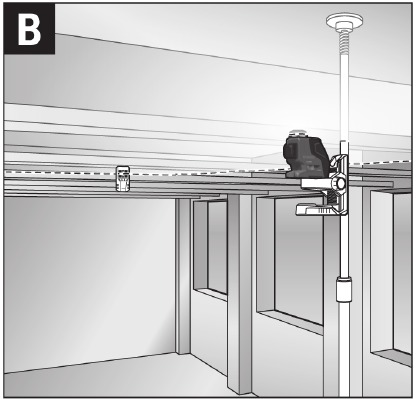
Working with the Laser Receiver
(Accessory) (see figure B)
Under unfavorable light conditions (bright environment, direct sunlight) and for larger distances, use the laser receiver 25 for improved finding of the laser lines. When working with the laser receiver, switch the pulse function on (see "Receiver Mode").
Laser Viewing Glasses
(Optional Accessory)
The laser viewing glasses filter out the ambient light. This makes the red light of the laser appear brighter for the eyes.
- Do not use the laser viewing glasses as safety goggles. The laser viewing glasses are used for improved visualization of the laser beam, but they do not protect against laser radiation.
- Do not use the laser viewing glasses as sun glasses or in traffic. The laser viewing glasses do not afford complete UV protection and reduce color perception.
Work Examples
(see figures A–F)
See the applicational examples for the tool below.
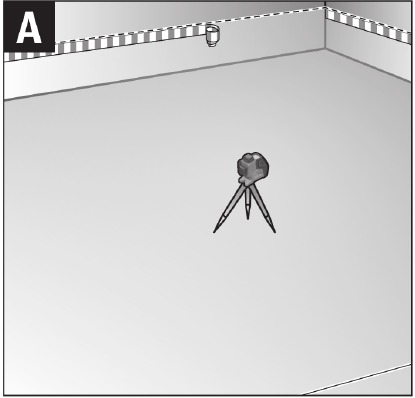
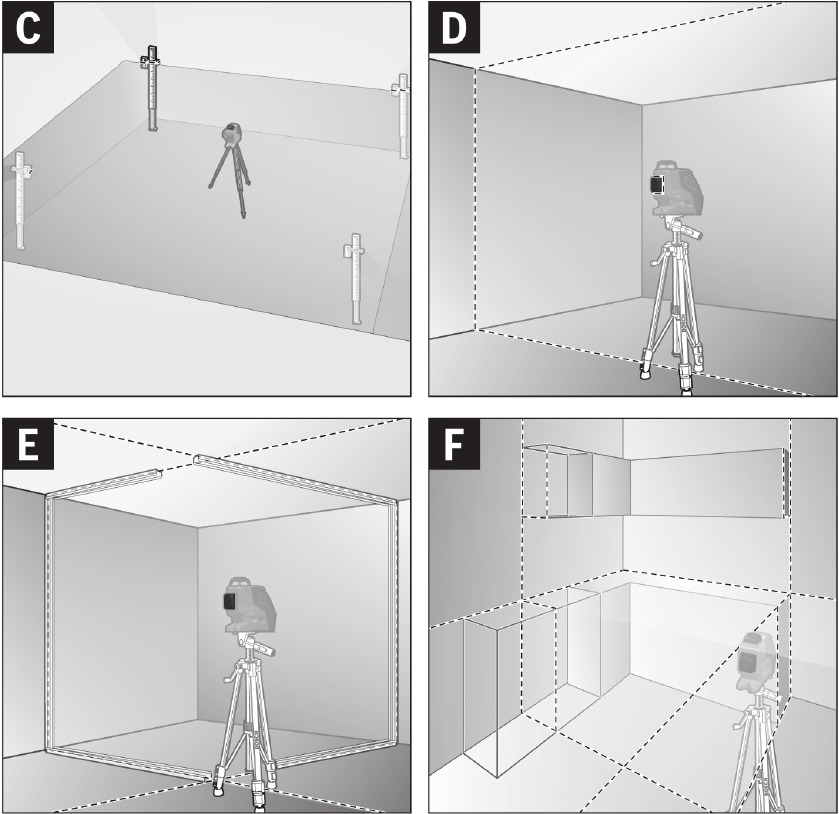
Maintenance and Service
Store and transport the tool only in the supplied protective case.
Keep the tool clean at all times.
Do not immerse the tool into water or other fluids.
Wipe off debris using a moist and soft cloth.
Do not use any cleaning agents or solvents
If the tool should fail despite the care taken in manufacturing and testing procedures, repair should be carried out by an authorized after- sales service center for Bosch power tools.
In all correspondence and spare parts orders, please always include the 10-digit article number given on the type plate of the tool.
In case of repairs, send in the tool packed in its protective pouch 28.
LIMITED WARRANTY
Bosch will extend warranty coverage to two (2) years when you register your product within eight (8) weeks after date of purchase. Product registration card must be complete and mailed to Bosch (postmarked within eight weeks after date of purchase), or you may register on-line at www.boschtools.com/Service/ProductRegistration. If you choose not to register your product, a one (1) year limited warranty will apply to your product.
To make a claim under this Limited Warranty, you must return the complete Bosch laser or measuring tool, transportation prepaid, to any BOSCH Factory Service Center or Authorized Service Center. Please include a dated proof of purchase with your tool. For locations of nearby service centers, please use our on-line service locator or call 1-877-267-2499.
For details to make a claim under this Limited Warranty please visit www.boschtools.com or call 1-877-267-2499.
Call Toll Free for Consumer Information & Service Locations
1-877-BOSCH99 (1-877-267-2499) www.boschtools.com
Documents / Resources
References
Download manual
Here you can download full pdf version of manual, it may contain additional safety instructions, warranty information, FCC rules, etc.
Advertisement





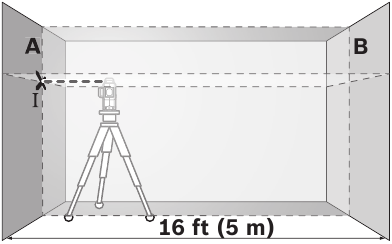
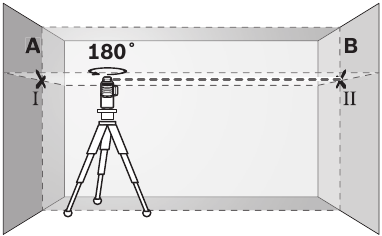
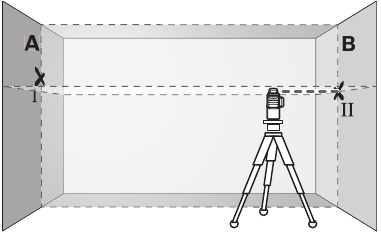
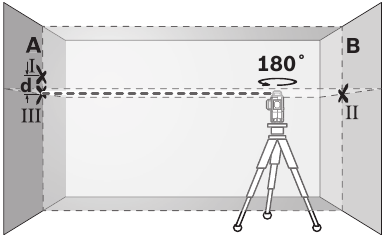
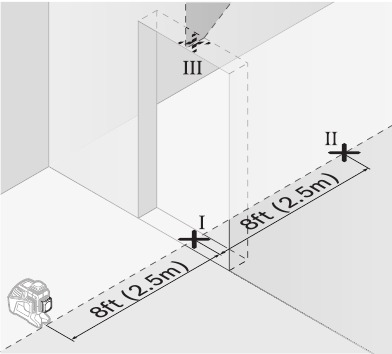





















Need help?
Do you have a question about the GLL3-330C and is the answer not in the manual?
Questions and answers